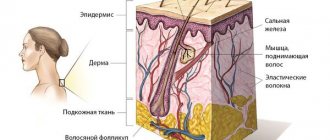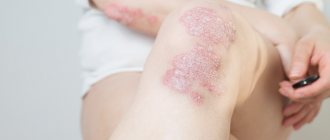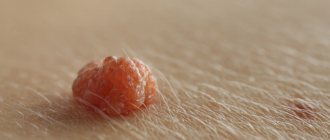There are many chilling legends around moles and their removal, but which of them are true, and which have only a distant relation to reality?
“A friend of a classmate’s brother was shaving, accidentally cut off a mole and “burned” from cancer in 2 weeks.” “My fourth cousin picked off a mole with her bra and died of lymph node cancer at the age of 40.” “The child is sent for mole removal. The whole family has been crying for a week now. What are our chances of survival? “I heard that not everyone survives after mole removal. Therefore, I remove them at home myself using a celandine solution. And my grandfather bandages a mole on a stalk with a hair, and it falls off.” “The beautician at the salon told me that I need to remove all the moles on my body so that they don’t turn into cancer. This can be done for just 20 thousand rubles.”
The appearance of such horror stories is associated with low awareness of the population regarding the issue of benign and malignant skin formations. It’s good that now we have many opportunities to learn everything about our moles. Firstly, you can always seek advice from a dermato-oncologist at the KVD (in the regions) or the branch of the Medical Research and Clinical Center of the Moscow Health Department (in Moscow) at your place of residence, it is free. Dermato-oncology is a narrow specialization in dermatology that deals with various skin formations (or moles, as patients say). Secondly, for 12 years in Russia at the end of May, a charity project “Melanoma Diagnosis Day” has been held, within the framework of which any person can undergo a free dermatoscopy procedure (examination of moles at tenfold magnification) and ask all the questions of interest to the doctor. Melanoma is a malignant tumor masquerading as a mole. It develops from melanocytes, pigment cells of the skin, rapidly progresses and quickly metastasizes. It is rightfully considered the most malignant human tumor. Globally, 232,000 new cases are reported annually.
What types of “moles” are there?
When pronouncing the word “mole,” the patient means a permanent spot or nodule on the skin. In fact, there are hundreds of types of benign skin formations that can be called this. Here are the most common ones.
Hemangioma or “red mole”
This is a benign formation consisting of vascular tissue cells. At least one hemangioma can be found in every adult. They look like red/cherry dots or appear as spider veins (spider hemangioma). They can appear spontaneously throughout life, sometimes at the site of injury or inflammation (for example, at the site of a pimple). This is an absolutely benign formation, it does not turn into cancer. To be removed for cosmetic purposes only.
Keratoma
A benign skin formation consisting of epidermal cells. In the old books they were called “senile”, but this definition is not used now, since they can also occur in young people. A keratoma looks like a gray or brown spot protruding above the skin with a rough surface. Their typical location is in areas exposed to solar radiation (face, chest, upper limbs) or places of constant trauma (under laundry straps and elastic bands). Keratomas almost never become malignant, but they can actively grow, itch and bleed. Therefore, dynamic monitoring of these formations is necessary. Can be removed for cosmetic purposes.
Acrochordon (fibroepithelial polyp or “papilloma”)
A benign skin formation, representing a soft polyp on a flesh-colored stalk. Usually occurs in places of mechanical friction and in skin folds, the elements can be located in groups. Doctors often associate these tumors with the papilloma virus. Acrochordons are recommended to be removed as they tend to grow and spread and can become a serious cosmetic problem. They do not pose a danger to life or health.
Melanocytic nevus (mole, birthmark)
A benign congenital or acquired skin formation consisting of melanocytes (pigment cells of the skin). This is a flat spot or plaque raised above the skin, most often brown in color. More than 10 types of nevi have been described. On average, an adult has 20-30 such moles on his body. They appear and grow under the influence of ultraviolet radiation. Requires dynamic monitoring, the risk of degeneration into melanoma is 1:200,000. They can be removed by a dermatologist, dermato-oncologist or cosmetologist with subsequent referral for histological examination.
Reasons for appearance
It is almost impossible to absolutely accurately establish the etiotropic factor in the appearance of white moles. In medical practice, there are several possible causes for the appearance of nevi of various types, including white ones:
- Hormonal changes in the body (pregnancy, puberty, taking hormonal drugs for a long time, etc.);
- Inflammatory processes on the skin (acne, rash);
- Hereditary predisposition;
- Chronic bacterial or viral diseases;
- Constant nervous tension;
- Ultraviolet irradiation;
- Bad ecology.
Whatever the reason for the appearance of a white mole, you need to periodically pay attention to it and, if you notice any changes, immediately consult a doctor.
When should you be wary and consult a doctor to rule out malignancy of the nevus?
- changing the shape of a mole from round to asymmetrical
- rapid growth of moles, sizes more than 6 mm.
- the contours of the mole have become uneven, the edges are “ragged”
- change in color of the mole, it becomes uneven or blue-black
- the surface of the mole has become glossy and shiny
- an ulcer spontaneously appeared on the mole
- loss of hair that previously grew from a mole
- the mole has become dense to the touch
- the appearance of “child” elements around the mole
- feeling of itching in the mole area
- enlargement of nearby lymph nodes
If you consider yourself at risk, have discovered one of the above signs, or are simply worried about this, make an appointment with a dermato-oncologist. And please never forget to use sunscreen.
What are moles?
Every child is unique, and every mole is too. From the name you can easily guess that moles are spots that are on the baby’s skin from birth. There is also a theory that identical “marks” on the body were a sign of the same genus. Some moles form before the baby is born and are immediately visible. Others are present on the skin “in theory,” but only appear some time after birth.
Moles can differ significantly from each other in appearance: some can be flat, others can be convex, some can be regular in shape, others can have uneven edges. Colors can vary from yellowish and brown to red and blue.
Most often, moles on the skin are not dangerous. Some even shrink in size or fade completely over time. In rare cases, moles can be a symptom of an underlying disease. In any case, if your baby's moles cause you concern, consult your pediatrician.
Special attention area
The transformation of a benign tumor into a malignant one can occur slowly, over several months or years, or it can happen suddenly, in a very short time. But if trouble strikes, dangerous cells will begin to divide rapidly, so it is important not to miss the moment and undergo regular preventive medical examinations. Please note: in these cases, you need to run to the dermatologist as fast as you can.
- Pigment formations of asymmetrical, irregular shape and outline, similar to a geographical map.
- Multi-colored moles with shades of brown, red, gray and blue.
- The nodules are regular in shape, but unevenly colored.
- Sharply growing moles.
- Causes concern - itches, hurts or bleeds.
- Eight spots larger than 6 mm.
- Multiple scatterings (from 50 pieces) larger than 2 mm.
Pigmentless flat nevi
A white mole most often does not grow, does not bother, and does not itch. It is oval and has clear contours. Comes in different sizes. It can be either congenital (in children) or newly formed (in adults), which often indicates the presence of vitiligo.
- Duplex scanning of the vessels of the lower extremities
- Melanoma with metastases: diagnosis, treatment, prognosis
- A sick gastrointestinal tract is a risk zone for Covid-19
Sometimes many small bulges form that are invisible to the naked eye. Up to ten pieces they do not cause any discomfort.
Hanging nevi may also appear, which they try to get rid of immediately (they are more likely to be injured than others).
Postoperative period
What is needed after removing white moles using electrocoagulation? Everything is quite simple - take care of your skin by treating it with an antiseptic.
It is also important to protect the area from exposure to UV rays, moisture and not to use cosmetics. Do not touch the crust; after a while it will fall off on its own.
White Spot Meaning
Astrologers say that the location of moles on the body can say a lot about a person.
| Localization of nevus | Meaning |
| Face, head | The mole adds piquancy and a special “zest” to the image. Indicates the beauty and attractiveness of the owner. |
| Forehead | Hard work. |
| Cheeks | Kindness, good nature. |
| Shoulders | Life wisdom, prudence. |
| Hands | Localized on the right hand - a person will have a start in business, a successful career, on the left - hard work. |
| Breast | For a man – confidence, optimism, focus on success. For a woman, this is a sign that she will be a good mother. |
| Back | Honesty, sincerity, loyalty. |
| Stomach | White birthmarks on the stomach mean wealth. |
| Legs | Difficulties on the path of life. |
Sometimes groups of nevi form a geometric figure.
The meaning of spots when a group of nevi appears:
| Form | Meaning |
| Star | Talent. |
| Triangle | A sign of success in creativity and business. |
| Heart | There is love in the life of the owner of the mole. |
| Constellations | A random event will change your life. |
The data given above does not have a medical basis and is given for general development.
Treatment options
In the absence of signs of unfavorable development of white moles, targeted treatment is not required. You just need to take measures to strengthen your immune system:
- increase the consumption of vegetables, fruits of yellow, orange and red shades;
- reduce the amount of animal proteins in the diet;
- monitor the general condition of the body.
It is better to eliminate white birthmarks with ointments, and if they do not help, with surgery.
Drug therapy is not recommended for children under 5 years of age. But if the pigmentation has not recovered by this time, then a comprehensive examination of the body should be carried out to find the reason for this. For medical reasons, children may be prescribed:
- hormonal ointments;
- B vitamins;
- treatment of affected areas with extracts of medicinal herbs.
Mole removal
The advisability of surgical removal can only be determined by a doctor who can offer the following methods for this purpose:
- surgery using a scalpel;
- laser removal;
- electrocoagulation;
- cryodestructive method, in which freezing occurs with nitrogen or carbonic acid;
- electrocoagulation;
- radiosurgery method.
Parents should remember that if there is no harm to the child’s health, there is no need to resort to surgical intervention. The same applies to adults. The prognosis for such moles is quite favorable if you monitor their condition, shape, and visit a doctor if there is the slightest change. White moles can remain on the skin for a long time without causing noticeable discomfort.
Variety of light nevi
Externally, there are such moles:
- flat;
- melacite;
- non-cellular;
- warty;
- organoid.
To fully understand what white moles mean, you need to undergo an examination.
Formation
First of all, it should be noted that moles in which blood vessels have formed are dangerous forms. Particular attention should be paid to those formations that do not have increased melanin density. They can be located on any part of the body. In addition, they can be found on the head and face.
If a birthmark appears in the area of the hands, on the back, feet, neck, chest, then its owner will have to be more careful so as not to accidentally cause damage. The most inconvenient place for a mole is the eyelid; it interferes with movement and full vision.
It is believed that nevi appear at the site of a diseased organ. Experts often predict degeneration into cancer cells based on location.
White spots around moles should be alarming, but those with flat, brown spots can relax. Pale-shaded ones “live with the owner” until old age.
Dimensions
Most often, white moles are small or medium in size. However, you can find giant spots, the diameter of which can exceed 10 cm.
The classification of spots is carried out depending on the depth of their location in the dermis: superficial, borderline and intradermal (deep).










